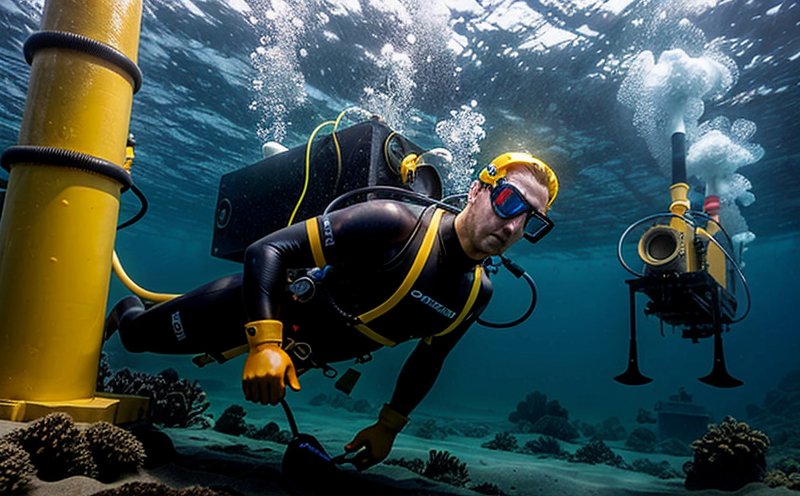API 6A Subsea Valve Pressure Testing
The API 6A standard is a key reference in the design and testing of subsea valves used in offshore oil and gas production systems. These valves are critical components that ensure safe, reliable operation under harsh conditions. The API 6A specification covers various aspects such as material selection, manufacturing processes, and testing procedures to guarantee the integrity and performance of these valves.
The pressure testing is a crucial step in this process. This test aims to verify the structural strength and sealing capability of subsea valves under simulated operating conditions. The primary goal is to ensure that the valve can withstand the extreme pressures found in deep-sea environments without failure or leakage, thereby maintaining safety and efficiency.
The testing procedure involves subjecting a sample valve to specified pressure levels for a defined period. This process simulates real-world operational stress and helps identify potential weaknesses before they become critical issues during deployment. The test setup typically includes high-pressure vessels capable of replicating the oceanic depths where these valves will function.
The instrumentation used in this testing is sophisticated, incorporating advanced sensors to monitor pressure, temperature, and other parameters throughout the test cycle. These measurements are crucial for ensuring accurate assessment of valve performance. After the test, a detailed analysis of the results is conducted to determine compliance with API 6A requirements.
Proper specimen preparation is essential for this testing. The valves must be cleaned thoroughly and inspected visually before being placed in the pressure vessel. Any imperfections or anomalies detected during inspection are rectified prior to testing. This ensures that any failure observed during the test can be attributed solely to the valve's design, material properties, or manufacturing processes.
Compliance with API 6A standards is not only about meeting regulatory requirements but also about ensuring the highest level of safety and reliability in subsea operations. For quality managers and compliance officers, this means verifying that all tests are conducted according to the specified protocols outlined in the standard. R&D engineers benefit from understanding these testing procedures as they contribute to continuous improvement of valve designs.
For procurement professionals, ensuring access to reliable third-party laboratories with expertise in API 6A testing is vital. This allows for the consistent quality assurance needed across different projects and locations. By focusing on the technical aspects and real-world implications of this test, we can appreciate its importance in safeguarding subsea operations.
- Visual inspection
- Cleaning procedures
- Pressure vessel setup
- Sensor instrumentation
- Data analysis techniques
Why It Matters
The importance of API 6A subsea valve pressure testing cannot be overstated. In the context of offshore oil and gas production, these valves are exposed to some of the harshest conditions imaginable—extreme pressures, corrosive environments, and fluctuating temperatures. Ensuring their integrity is paramount for preventing costly downtime, environmental damage, and most importantly, accidents that could endanger lives.
The API 6A standard provides a framework that helps manufacturers produce valves capable of withstanding these challenges. By adhering to this standard, industries can rely on consistent quality across different suppliers and locations. This consistency is crucial for maintaining operational continuity and ensuring compliance with international regulations.
From an environmental perspective, reliable subsea valves are essential in preventing leaks that could lead to oil spills or other forms of pollution. The pressure testing ensures that any potential flaws are identified early on, minimizing the risk of such incidents during deployment. For quality managers and R&D engineers, this test is a vital part of their efforts to innovate and improve valve designs.
The safety implications of this testing extend beyond the immediate environment; they have broader impacts on the global energy sector and environmental conservation efforts. By investing in robust subsea valves through rigorous testing like API 6A, industries contribute to safer operations and more sustainable practices.
Why Choose This Test
Selecting the appropriate pressure test for your subsea valve is a decision that significantly impacts its operational reliability. The API 6A standard offers comprehensive guidelines that cover every aspect of testing, from initial design to final inspection. By choosing this test, you ensure compliance with internationally recognized standards, which not only enhances credibility but also simplifies the regulatory process.
The robustness and accuracy of API 6A tests are backed by extensive research and development efforts. This ensures that the test protocols are up-to-date and reflective of current industry best practices. For quality managers, this means having reliable data to support decision-making processes regarding valve selection and procurement. Compliance officers can leverage these standards to streamline audits and ensure adherence to legal requirements.
For R&D engineers, API 6A testing provides a benchmark against which new designs can be validated. The real-world applicability of the test ensures that innovations are practical and effective in challenging marine environments. This approach fosters a culture of continuous improvement within engineering teams.
In summary, choosing API 6A subsea valve pressure testing demonstrates a commitment to excellence in product quality and operational safety. It positions your organization at the forefront of industry standards, ensuring that you can meet the highest expectations of both clients and regulators.
Quality and Reliability Assurance
- Visual Inspection: Ensures no visible defects or anomalies are present before testing.
- Cleaning Procedures: Removes any contaminants that could affect test results.
- Pressure Vessel Setup: Replicates deep-sea operational conditions for accurate simulation.
- Sensor Instrumentation: Monitors critical parameters during the pressure application process.
The API 6A standard emphasizes the importance of these steps in ensuring reliable and repeatable test results. By adhering to this protocol, laboratories can provide assurance that every valve tested meets stringent quality criteria. This level of reliability is essential for maintaining trust within the industry and fostering innovation.





